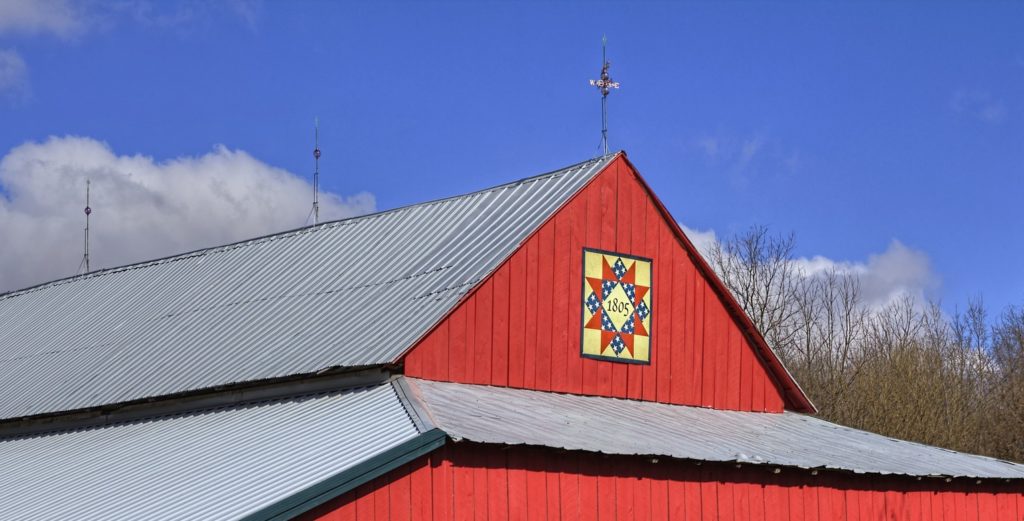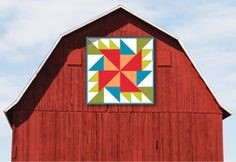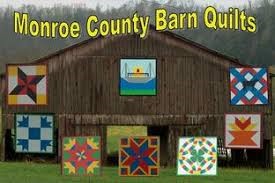Cleo Thoughts, Quilts
Quilting a Barn
 “Barn quilts are rural gifts, a bright spot along America’s highways and byways.” -Bonnie K. Hunter
“Barn quilts are rural gifts, a bright spot along America’s highways and byways.” -Bonnie K. Hunter
Women love to decorate their homes with their personality displayed with the choices of color, texture and form. Once the inside of a home is complete, it is natural to look outward. To the side of the barn. It started with a simple star.

Barn Stars
It was inevitable that the barn star would morph into something more creative, unique and personal. Back in the 1700’s, Amish country started boasting wooden decorative stars on the faces of barns. Whether the stars beamed with three or four or more points depended upon the maker. The star itself did not hold the “meaning”. The color of the star gave the significance.

Artist Suzi Parron, Dairy Barn Arts Center
The color of the star signified the emotion of the maker. Black means protection, blue is for peace, brown for strength, green indicates growing, orange signifies abundance, red sparks passion, violet indicates the sacred, white is the symbol for purity, and yellow brings a connection to God. Loosely translated, a barn with several stars of varying colors is sending a subtle message from the woman on the farm to passer-bys.
For decades, the barn stars remain the standard decoration.
Barn Quilts
With patchwork quilts representing the creativity of the stitcher, art based on these patterns for the barn is a logical leap. The concept of “barn quilts” is the brain storm of Donna Sue Groves in 2001. She worked with the Ohio Arts Council to produce a driving trail of twenty quilt squares on community barns in Adams County, Ohio. Each barn is decorated with a large painted patchwork square that celebrates the sewing heritage of the Appalachian area. She wanted to honor her mother, Maxine, with these spectacular quilts hung on the sides of barns. Quilters recognize the painted blocks and smile. The masterpieces speak without words to passer-bys.
Since then, farmers and quilters in Brown County, Ohio, and others in Tennessee have fostered new trails for visitors to admire. Iowa, Wisconsin, and Illinois all have their own barn quilt trails to bring slow moving cars across their landscape. Kentucky is home to about 800 painted quilts. Over 7,000 quilts are part of organized trails in the US and Canada. For a couple with an RV, this is a sight- seeing dream.

Mural Quilts
On the west coast, in Walla Walla, Washington, artist Mary Crane Nutter paints “mural quilts” because it’s less suggestive of where the art is hung. She considers her work to be an extension of the barn-quilt tradition of the Swiss and German immigrants of the 1800’s who believed that the colorful squares brought good fortune, successful harvest, and celebrated their European heritage. Mary uses geometric patterns and unique color combinations with a nod at traditional quilting designs.

Monroe County Barn Quilts
Mary Crane Nutter explains: “The idea of barn quilts isn’t mine, but I adore the long history and symbolism those quilts represent. My desire is to take it to a new, modern place.”
Painting a Blessing
Barn stars, quilts or murals are now decorative items on the sides of barns where women have brought their creative souls outside. To make a statement in color and design. To bring beauty to a plain surface. To express a blessing inspired by the palette and pattern of their art.
“When I am painting, my mind quiets, and I’m able to act on instinct- a deep sense of what feels right. It is meditative and allows me to express what can’t be put into words.” -Mary Crane Nutter, Quilt muralist
Photo credits:
https://www.notonthehighstreet.com/theoriginalhomestore/product/traditional-metal-amish-barn-stars
https://pixabay.com/en/barn-rustic-barns-quilt-quilt-barn-2693775
https://pixabay.com/en/barn-rustic-barns-quilt-quilt-barn-2689966
https://pixabay.com/en/barn-rustic-barns-quilt-barn-ohio-2637588

